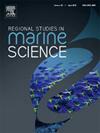水沙调节驱动黄河口多类群生物多样性和生态网络动态
IF 2.1
4区 环境科学与生态学
Q3 ECOLOGY
引用次数: 0
摘要
黄河高输沙要求水沙调节方案(WSRS)对泥沙和水流进行控制,导致黄河河口(YRE)环境发生显著变化,生物多样性发生显著变化。本研究利用环境DNA方法评估了长江三角洲无脊椎动物和鱼类的生物多样性和群落结构的变化。COI共鉴定出301种无脊椎动物,无脊椎动物群落在2022年7 - 8月保持稳定。鱼类多样性显著下降,共检测到14种。基于COI的群落稳定性分析显示,8月份无脊椎动物群落的平均关联度增加,连接程度强,但模块化程度降低,共现网络由多模块(7月)向单一优势结构(8月)转变。优势种S. crassa丰度从7月的24 %显著下降到8月的7 % (p <; 0.05),但在无脊椎类群中起着桥梁作用。冗余分析显示,在温度、pH、溶解氧、硝酸盐氮和氨氮的驱动下,7月和8月无脊椎动物类群发生了显著变化(p = 0.001)。鱼类主要受悬浮物和磷酸盐的影响。结果表明,环境因子对长江流域不同生物类群的影响是不同的。该研究有助于更好地理解水沙调控对长江三角洲生态结构的影响,为今后长江三角洲生态治理提供新的思路。本文章由计算机程序翻译,如有差异,请以英文原文为准。
Water-sediment regulation drives multi-taxon biodiversity and ecological network dynamics in the Yellow River Estuary
The Yellow River's high sediment load requires the Water-Sediment Regulation Scheme (WSRS) to manage sediment and water flow, leading to significant environmental changes and changes in biodiversity in the Yellow River Estuary (YRE). The present study used an environmental DNA approach to assess changes in biodiversity and community structure of invertebrates and fish in the YRE during WSRS. A total of 301 invertebrate species were identified using COI, and invertebrate communities remained stable from July to August 2022. Fish diversity declined significantly, with 14 detected species. Community stability analysis based COI revealed increased average degree and strong connections in invertebrates but reduced modularity in August, while the co-occurrence networks shifted from multiple modules (July) to a single dominant structure (August). Dominant species S. crassa abundance significantly declined from 24 % in July to 7 % in August (p < 0.05), but functioned as a bridging species in the invertebrate taxa. Redundancy analysis revealed significant shifts in invertebrate taxa between July and August (p = 0.001), driven by temperature, pH, dissolved oxygen, nitrate nitrogen, and ammonia nitrogen. Fish species were mainly influenced by suspended solids and phosphate. The results show that environmental factors have varying effects on different biological taxa in YRE. This study helps to better understand the impact of water-sediment regulation on the ecological structure and provides new insights for future ecological management in the YRE.
求助全文
通过发布文献求助,成功后即可免费获取论文全文。
去求助
来源期刊

Regional Studies in Marine Science
Agricultural and Biological Sciences-Ecology, Evolution, Behavior and Systematics
CiteScore
3.90
自引率
4.80%
发文量
336
审稿时长
69 days
期刊介绍:
REGIONAL STUDIES IN MARINE SCIENCE will publish scientifically sound papers on regional aspects of maritime and marine resources in estuaries, coastal zones, continental shelf, the seas and oceans.
 求助内容:
求助内容: 应助结果提醒方式:
应助结果提醒方式:


